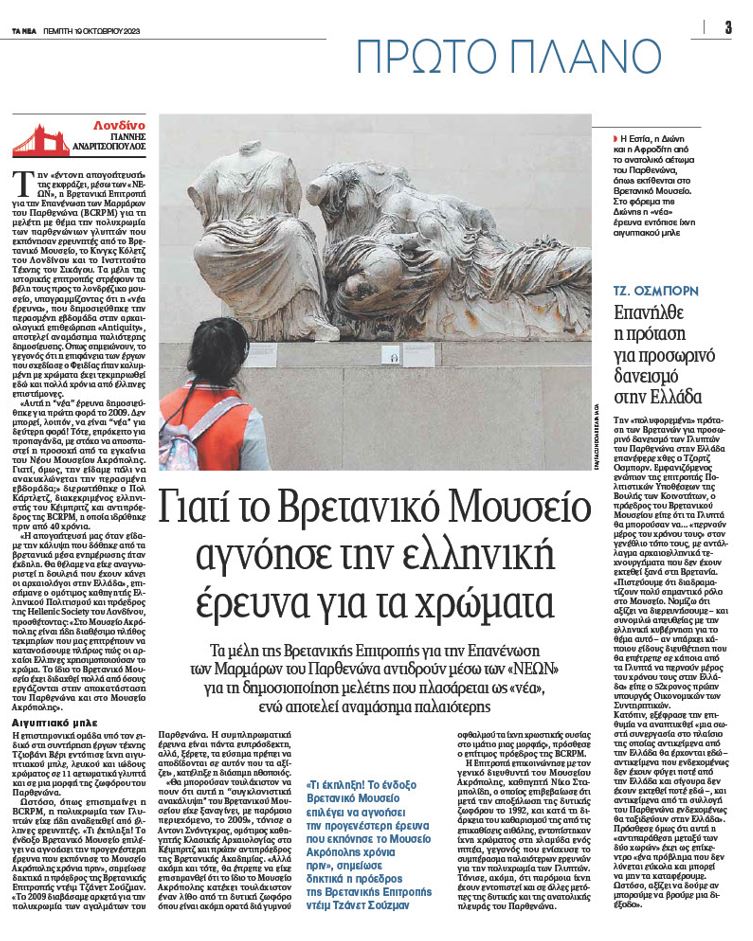That Greek temples and sculptures were coloured, both with 'applied' polychromy (paint) and 'natural' polychromy (the use of naturally coloured materials such as gold and ivory), has been known for centuries. So it was surprising to see a flurry of articles last week (11 October) praising the British Museum for new research that makes this discovery exciting.
Paul Cartledge, Vice-Chair of BCRPM was disappointed that the articles had not credited the Acropolis Museum also.

The articles were published in The Telegraph, The Times, The Guardian and The Daily Mail.
Professor Anthony Snodgrass, Honorary President of BCRPM, had released this statement in 2009, the press release issued then, can also be read here.
Anthony Snodgrass, in 2009, said : "The original presence of colour on the Parthenon Marbles has been a matter of common knowledge for years. What is more, ordinary viewers can still see, with their own eyes, traces of it (in this case, dark green) surviving on the drapery in at least one of the original slabs, from the West Frieze of the Parthenon, which is in the new museum in Athens. It hardly needs "a new imaging technique" to tell us what we can see for ourselves.”
In 2023, Anthony added:
'It was, I think, a Daily Telegraph journalist who described the new Acropolis Museum, before it was actually built, as 'a hideous visitor centre in Athens'. Perhaps it's asking too much for that newspaper to reconsider this judgment; but there might at least be some acknowledgment that this story of this 'huge breakthrough' by the British Museum, was first launched, in similar form, in 2009; and that even then it could be pointed out that the same Acropolis Museum holds at least one slab, from the Parthenon West Frieze, where you can still see the traces of coloured pigment, on one draped figure', with the naked eye.'
Is this news story published on the 11th of October 2023 more British Museum propaganda or just a diversionary story?
From Athens' Acropolis Museum, and the Director General of the museum Professor Sampolidis, a letterto BCRPM when we asked him about the polychromy of the sculptures.
We also reflect on Tom Flynn's writing, published fifteen years ago:
For generations it has been common knowledge among art historians and archaeologists that the Parthenon and its sculptures would originally have been decorated. Lawrence Alma-Tadema's painting of 1868 — Pheidias and the Parthenon Frieze— depicts the sculptor showing Athenian citizens around his team's handiwork high up on the scaffold.
By the mid-nineteenth century, a lively debate was raging in British scholarly circles over the question of polychromy, the colouring of sculpture.
Today, even virtual reality reconstructions of the Parthenon use nineteenth-century sources such as Benoit Loviot's Cross-Section of the Parthenon of 1879-81 (Ecole des Beaux-Arts Paris) as their guide to the use of colour on the Parthenon. These late nineteenth-century sources were themselves drawing on much earlier research by architects such as Jacques-Ignace Hittorff (1792-1867) and Quatremère de Quincy (1755-1849) which had established beyond doubt that Greek temples and sculptures were coloured, both with 'applied' polychromy (paint) and 'natural' polychromy (the use of naturally coloured materials such as gold and ivory).
Today, Thursday 19 October, Yannis Andritsopoulos, London correspondent for Greek newspaper Ta Nea has published his article, and you can read the original online here or the translation into English.
